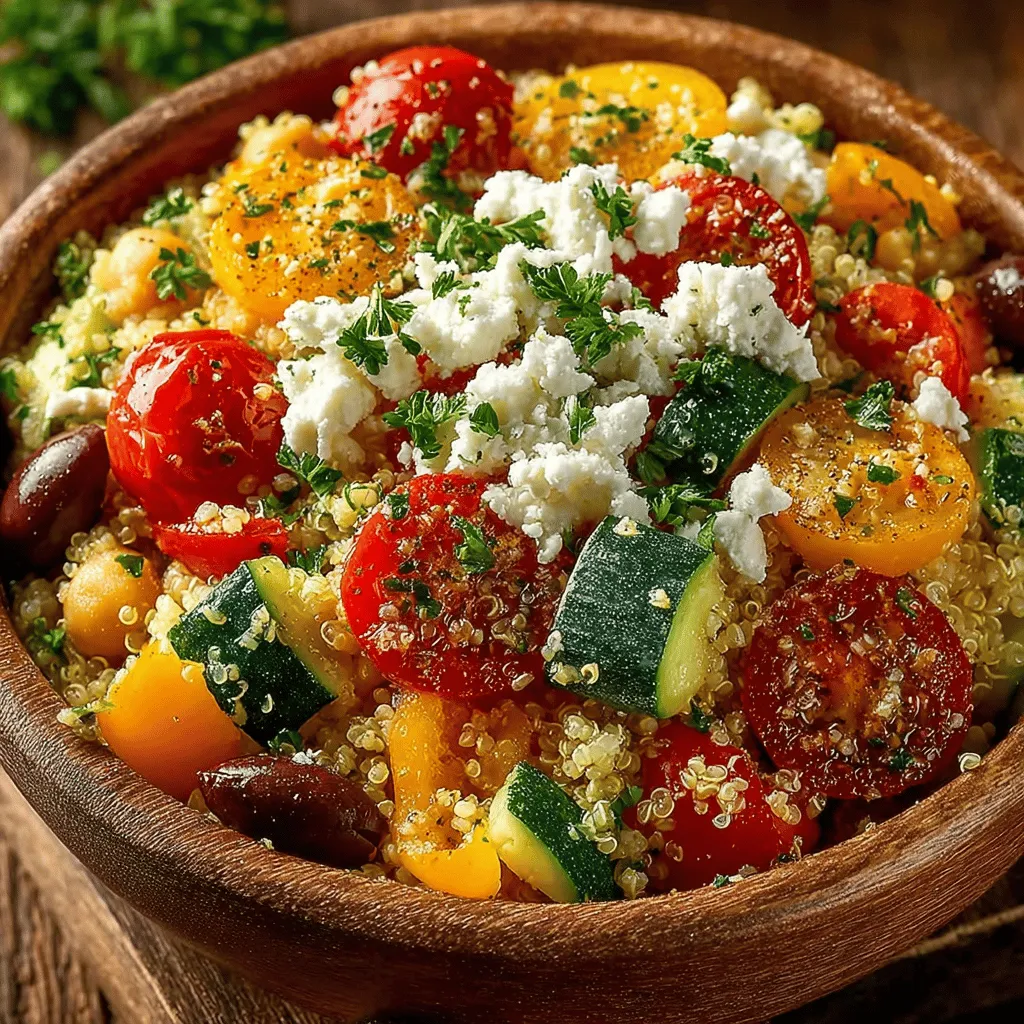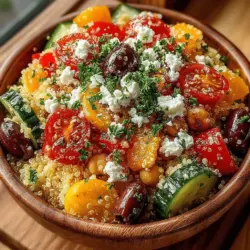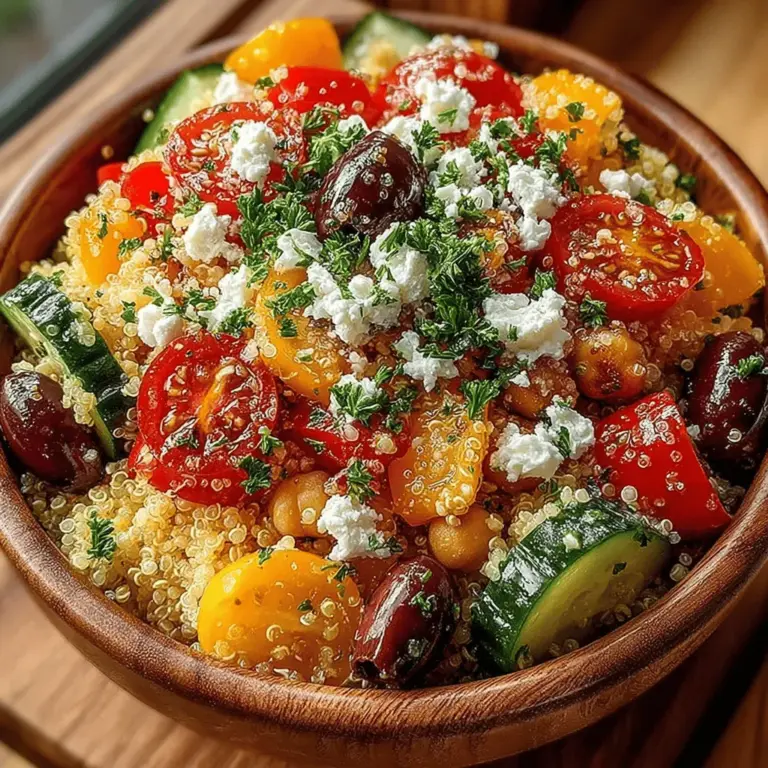Quinoa & Chickpea Mediterranean Bowl: A Healthy and Flavorful Recipe
In recent years, the trend toward healthy eating has gained significant momentum, with more individuals embracing diets rich in whole foods, plant-based ingredients, and international flavors. Among the various culinary traditions that promote health and wellness, Mediterranean cuisine stands out for its emphasis on fresh vegetables, legumes, whole grains, and healthy fats. The Quinoa & Chickpea Mediterranean Bowl embodies the essence of this vibrant culinary style, offering a nutritious, versatile, and easy-to-make meal that is perfect for any occasion.
This delightful bowl not only showcases the rich flavors of the Mediterranean but also highlights two powerhouse ingredients: quinoa and chickpeas. Quinoa, often referred to as a superfood, is celebrated for its impressive nutritional profile, while chickpeas are a staple in Mediterranean cooking, packed with protein and fiber. Together, they create a hearty base that can be easily customized with seasonal vegetables and your choice of toppings, making this dish both satisfying and nourishing.
Understanding the Ingredients
The Nutritional Power of Quinoa
Quinoa, native to the Andean region of South America, has been cultivated for thousands of years and is often considered a whole grain, although it is technically a seed. Its popularity has surged worldwide thanks to its impressive nutritional benefits. Quinoa is a complete protein, meaning it contains all nine essential amino acids that our bodies cannot produce on their own. This makes it an excellent choice for vegetarians and vegans seeking to meet their protein needs.
In addition, quinoa is gluten-free, making it suitable for those with gluten sensitivities or celiac disease. It is rich in fiber, which promotes digestive health and can help regulate blood sugar levels. Quinoa also boasts essential vitamins and minerals, including magnesium, iron, and B vitamins, contributing to overall health and wellness. With its nutty flavor and fluffy texture, quinoa serves as an ideal base for salads, bowls, and side dishes.
Chickpeas: A Mediterranean Staple
Chickpeas, also known as garbanzo beans, are a versatile legume that plays a pivotal role in Mediterranean cuisine. They are not only a delicious addition to many dishes, but they also offer numerous health benefits. Chickpeas are an excellent source of plant-based protein, making them a favored ingredient for those looking to boost their protein intake without relying on animal products.
Rich in dietary fiber, chickpeas can help promote feelings of fullness, making them a great option for weight management. They are also packed with essential nutrients, including folate, manganese, and phosphorus. Incorporating chickpeas into your diet can support heart health, improve digestion, and even help regulate blood sugar levels. Their earthy flavor and firm texture provide a satisfying contrast to the lightness of quinoa, making them a perfect pairing in this Mediterranean bowl.
Fresh Vegetables: The Heart of the Bowl
A Mediterranean bowl would not be complete without an array of fresh, seasonal vegetables. Using colorful produce not only enhances the visual appeal of the dish but also increases its nutritional value. Seasonal vegetables are often richer in flavor and nutrients, making them the ideal choice for this bowl.
Consider incorporating ingredients such as bell peppers, cucumbers, cherry tomatoes, red onions, and leafy greens. Each vegetable brings its own unique set of vitamins and minerals. For example, bell peppers are high in vitamin C, while cucumbers provide hydration and are low in calories. Tomatoes are a great source of antioxidants, particularly lycopene, which has been linked to various health benefits.
Optional Ingredients: Enhancing Flavor with Feta and Olives
To take the flavor profile of your Quinoa & Chickpea Mediterranean Bowl to the next level, consider adding optional ingredients such as feta cheese and olives. Feta cheese, with its tangy, creamy texture, complements the nuttiness of quinoa and the earthiness of chickpeas beautifully. It is also a source of protein and calcium, adding to the overall nutritional value of the dish.
Olives, particularly Kalamata olives, are another classic component of Mediterranean cuisine. They offer a rich, briny flavor that can elevate any salad or bowl. Olives are rich in healthy fats, particularly monounsaturated fats, which are beneficial for heart health. They also contain antioxidants and anti-inflammatory properties, making them a great addition to your meal.
Cooking Quinoa to Perfection
Now that we have an understanding of the key ingredients, let’s dive into the cooking process, starting with quinoa. Cooking quinoa might seem straightforward, but achieving the perfect texture and flavor requires a few important steps.
Rinsing and Cooking Quinoa
Before cooking quinoa, it is essential to rinse it thoroughly under cold water. Quinoa seeds are coated with a natural substance called saponin, which can impart a bitter taste if not washed away. Rinsing not only removes this coating but also enhances the flavor of the cooked quinoa.
To cook quinoa, use a 2:1 ratio of liquid to quinoa. While water is often used, consider using vegetable broth for added depth of flavor. The broth infuses the quinoa with savory notes, making it a more flavorful base for your bowl. Bring the liquid to a boil, add the rinsed quinoa, and then reduce the heat to a simmer. Cover the pot and let it cook for about 15 minutes, or until the quinoa has absorbed all the liquid and is tender.
Achieving Perfect Texture and Fluffiness
Once the quinoa has cooked, remove it from heat and let it sit for an additional five minutes with the lid on. This resting period allows the quinoa to steam and become even fluffier. Afterward, use a fork to fluff the quinoa gently, separating the grains. This step is crucial for achieving that light, airy texture that makes quinoa so enjoyable to eat.
Preparing the Vegetables
With the quinoa cooking, it’s time to turn our attention to the fresh vegetables that will bring our Mediterranean bowl to life. The key to a successful dish is not only in the ingredients but also in how they are prepared.
Importance of Fresh, Colorful Veggies
Fresh vegetables are the heart of the Quinoa & Chickpea Mediterranean Bowl, contributing both flavor and nutrition. Using a variety of colors not only enhances the visual appeal but also ensures a diverse range of nutrients. Aim for vibrant hues, as they often indicate a wealth of vitamins and antioxidants.
Detailed Preparation Methods
Start by washing your vegetables thoroughly under cold water. For bell peppers, remove the seeds and stem, and chop them into bite-sized pieces. For cucumbers, you can either peel them or leave the skin on for added texture and nutrients. Slice them into rounds or half-moons, depending on your preference.
Cherry tomatoes can be halved or left whole, while red onions should be sliced thinly to provide a sharp contrast to the other ingredients. Leafy greens, such as spinach or arugula, can simply be torn or chopped into manageable pieces.
Uniformity in size is important for even cooking and presentation. If preparing vegetables in advance, store them in airtight containers in the refrigerator to maintain their freshness and crispness.
Storing Prepped Vegetables
For those who love meal prep, having prepped vegetables on hand can save time during busy weekdays. Store chopped vegetables separately in airtight containers, ensuring that they are dry to prevent spoilage. Most chopped vegetables can last about three to five days in the refrigerator, making it easy to assemble your Mediterranean bowl at a moment’s notice.
With the quinoa cooking and the vegetables prepped, you’re well on your way to creating a delicious and healthy Quinoa & Chickpea Mediterranean Bowl. The next step will be to bring all these vibrant ingredients together, but we’ll save that for the next section.

Creating a delightful Quinoa & Chickpea Mediterranean Bowl is an enriching culinary experience that brings the vibrant flavors of the Mediterranean to your kitchen. In this section, we will dive into detailed instructions for combining the ingredients, explore the dressing’s significance, provide serving suggestions and variations, break down the nutritional benefits, discuss storage and meal prep tips, and conclude with an invitation to embrace healthy cooking.
Detailed Instructions for Combining Ingredients
To achieve the optimal flavor and presentation in your Quinoa & Chickpea Mediterranean Bowl, it’s essential to layer your ingredients thoughtfully. Start by preparing your quinoa according to package instructions, allowing it to cool before mixing. This step is vital as warm quinoa could wilt delicate greens and alter the texture of other ingredients.
1. Prepare the Base: In a large mixing bowl, combine the cooled quinoa and drained chickpeas. Gently fold them together using a spatula to avoid mashing the chickpeas. This combination serves as the protein-rich base of your bowl.
2. Add Fresh Vegetables: Incorporate diced cucumbers, halved cherry tomatoes, and finely chopped red onion. These fresh ingredients add a crisp texture and vibrant colors to your bowl. For an optimal mix of flavors, consider adding a handful of chopped parsley or mint, which complements the Mediterranean theme beautifully.
3. Incorporate the Dressing: Next, drizzle your prepared dressing over the mixture. The dressing not only enhances the flavor but also ties the ingredients together. Toss everything gently, ensuring that each ingredient is coated evenly with the dressing. This step is crucial for achieving a harmonious blend of flavors in every bite.
4. Top with Feta (Optional): If you’re using feta cheese, crumble it over the top of the bowl last. This allows the cheese to maintain its texture and adds a delicious salty contrast to the freshness of the vegetables.
The Significance of the Dressing
The dressing for your Mediterranean bowl is a key element that enhances its flavor profile. A classic Mediterranean dressing typically consists of olive oil, lemon juice, garlic, salt, and pepper. Here’s why these ingredients work so well together:
– Olive Oil: Rich in healthy fats, olive oil adds a silky texture and depth of flavor. It also acts as a carrier for fat-soluble vitamins found in vegetables.
– Lemon Juice: The acidity of lemon juice brightens the dish and balances the richness of the olive oil. It also adds a refreshing zing that complements the earthy flavors of quinoa and chickpeas.
– Garlic: Fresh minced garlic offers a zesty kick that elevates the overall taste. It’s a staple in Mediterranean cuisine, known for its health benefits and aromatic qualities.
– Salt and Pepper: These simple seasonings enhance all the flavors, bringing out the best in each ingredient.
Tips for Tossing and Mixing
To ensure an even distribution of flavors in your bowl, here are some tips:
– Use a large mixing bowl to give yourself enough space to toss the ingredients without spilling.
– Start by mixing the quinoa and chickpeas first, as they form the base. This allows you to control the mixture’s texture before adding more delicate ingredients.
– When adding the dressing, start with a small amount and gradually increase it to avoid over-dressing.
– Use a folding motion rather than stirring aggressively. This technique helps maintain the integrity of the chickpeas and vegetables.
Serving Suggestions and Variations
Plates vs. Meal Prep Containers
You can serve your Quinoa & Chickpea Mediterranean Bowl in various ways:
– Plated Presentation: For a more elegant presentation, serve the bowl on a wide, shallow plate. Layer the ingredients artfully, placing the quinoa and chickpeas at the center, surrounded by colorful vegetables and topped with feta.
– Meal Prep Containers: If you’re preparing meals for the week, opt for meal prep containers. Layering the ingredients in clear containers not only keeps them fresh but also makes them visually appealing. Keep the dressing separate until you’re ready to eat to prevent the ingredients from getting soggy.
Ingredient Substitutions or Additions
This Mediterranean bowl is highly customizable, making it suitable for various dietary needs:
– Vegan Options: Omit the feta cheese and consider adding avocado or nutritional yeast for creaminess and flavor.
– Gluten-Free: This recipe is naturally gluten-free as it uses quinoa, but always check your ingredients for any gluten-containing additives.
– Additional Proteins: Consider adding grilled chicken, shrimp, or roasted tofu to increase the protein content and cater to different tastes.
Customizing the Bowl for Different Tastes
– Spice it Up: If you enjoy heat, add a sprinkle of red pepper flakes or some diced jalapeños.
– Herb Variations: Experiment with different herbs like dill, basil, or cilantro to change the flavor profile.
– Diverse Grains: Replace quinoa with brown rice or farro for a different texture and taste.
Nutritional Breakdown
The Quinoa & Chickpea Mediterranean Bowl is not only delicious but also packed with nutrients:
– Health Benefits: Quinoa and chickpeas are excellent sources of plant-based protein, fiber, and essential vitamins and minerals. They support muscle repair, digestive health, and overall well-being.
– Caloric Information: A typical serving of this bowl (approximately 1.5 cups) contains about 400-500 calories, depending on the quantity of dressing and additional toppings used.
– Macro Breakdown:
– Carbohydrates: 50-60 grams
– Proteins: 15-20 grams
– Fats: 15-20 grams (primarily from olive oil and optional feta)
This dish serves as a balanced meal, providing a good mix of macronutrients while being low in saturated fats. It’s suitable for those following a vegetarian, vegan, or gluten-free diet.
Storing and Meal Prep Tips
To enjoy your Quinoa & Chickpea Mediterranean Bowl at its best, follow these storage and meal prep tips:
– Best Practices for Storing Leftovers: Store any leftovers in an airtight container in the refrigerator. The bowl will stay fresh for up to three days.
– Packing for Lunchboxes: When preparing this dish for lunches, portion it into individual containers. Keep the dressing in a separate small container to maintain the freshness of the ingredients throughout the day.
– Enjoying Cold or at Room Temperature: This Mediterranean bowl is versatile and can be enjoyed cold or at room temperature, making it perfect for picnics or lunches on the go.
Conclusion
The Quinoa & Chickpea Mediterranean Bowl is a healthy, delicious option for any meal, offering a delightful blend of flavors and textures. It showcases the vibrant tastes of the Mediterranean while providing essential nutrients that contribute to a balanced diet.
As you explore these Mediterranean flavors and incorporate more wholesome ingredients into your daily meals, you’ll discover the joy of cooking and sharing healthy recipes with loved ones. This bowl is not just a meal; it’s a celebration of fresh produce, hearty grains, and the delightful experience of enjoying food that nourishes both the body and soul. Enjoy your cooking adventure, and don’t hesitate to make this recipe your own!


